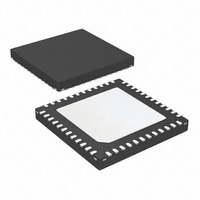AT91SAM7S32B-MU Atmel, AT91SAM7S32B-MU Datasheet - Page 163

AT91SAM7S32B-MU
Manufacturer Part Number
AT91SAM7S32B-MU
Description
IC MCU ARM7 32KB FLASH 48-VQFN
Manufacturer
Atmel
Series
AT91SAMr
Datasheet
1.AT91SAM7S16-MU.pdf
(779 pages)
Specifications of AT91SAM7S32B-MU
Core Processor
ARM7
Core Size
16/32-Bit
Speed
55MHz
Connectivity
I²C, SPI, SSC, UART/USART
Peripherals
Brown-out Detect/Reset, DMA, POR, PWM, WDT
Number Of I /o
21
Program Memory Size
32KB (32K x 8)
Program Memory Type
FLASH
Ram Size
8K x 8
Voltage - Supply (vcc/vdd)
1.65 V ~ 1.95 V
Data Converters
A/D 8x10b
Oscillator Type
Internal
Operating Temperature
-40°C ~ 85°C
Package / Case
48-VQFN Exposed Pad, 48-HVQFN, 48-SQFN, 48-DHVQFN
For Use With
AT91SAM-ICE - EMULATOR FOR AT91 ARM7/ARM9AT91SAM7S-EK - KIT EVAL FOR ARM AT91SAM7S
Lead Free Status / RoHS Status
Lead free / RoHS Compliant
Eeprom Size
-
Available stocks
Company
Part Number
Manufacturer
Quantity
Price
- Current page: 163 of 779
- Download datasheet (11Mb)
23.6
23.6.1
23.6.2
23.6.3
6175K–ATARM–30-Aug-10
Product Dependencies
I/O Lines
Power Management
Interrupt Sources
The interrupt signals FIQ and IRQ0 to IRQn are normally multiplexed through the PIO control-
lers. Depending on the features of the PIO controller used in the product, the pins must be
programmed in accordance with their assigned interrupt function. This is not applicable when
the PIO controller used in the product is transparent on the input path.
The Advanced Interrupt Controller is continuously clocked. The Power Management Controller
has no effect on the Advanced Interrupt Controller behavior.
The assertion of the Advanced Interrupt Controller outputs, either nIRQ or nFIQ, wakes up the
ARM processor while it is in Idle Mode. The General Interrupt Mask feature enables the AIC to
wake up the processor without asserting the interrupt line of the processor, thus providing syn-
chronization of the processor on an event.
The Interrupt Source 0 is always located at FIQ. If the product does not feature an FIQ pin, the
Interrupt Source 0 cannot be used.
The Interrupt Source 1 is always located at System Interrupt. This is the result of the OR-wiring
of the system peripheral interrupt lines, such as the System Timer, the Real Time Clock, the
Power Management Controller and the Memory Controller. When a system interrupt occurs, the
service routine must first distinguish the cause of the interrupt. This is performed by reading suc-
cessively the status registers of the above mentioned system peripherals.
The interrupt sources 2 to 31 can either be connected to the interrupt outputs of an embedded
user peripheral or to external interrupt lines. The external interrupt lines can be connected
directly, or through the PIO Controller.
The PIO Controllers are considered as user peripherals in the scope of interrupt handling.
Accordingly, the PIO Controller interrupt lines are connected to the Interrupt Sources 2 to 31.
The peripheral identification defined at the product level corresponds to the interrupt source
number (as well as the bit number controlling the clock of the peripheral). Consequently, to sim-
plify the description of the functional operations and the user interface, the interrupt sources are
named FIQ, SYS, and PID2 to PID31.
AT91SAM7S Series Preliminary
163
Related parts for AT91SAM7S32B-MU
Image
Part Number
Description
Manufacturer
Datasheet
Request
R

Part Number:
Description:
KIT EVAL FOR ARM AT91SAM7S
Manufacturer:
Atmel
Datasheet:

Part Number:
Description:
MCU, MPU & DSP Development Tools KICKSTART KIT ATMEL AT91SAM7S
Manufacturer:
IAR Systems

Part Number:
Description:
DEV KIT FOR AVR/AVR32
Manufacturer:
Atmel
Datasheet:

Part Number:
Description:
INTERVAL AND WIPE/WASH WIPER CONTROL IC WITH DELAY
Manufacturer:
ATMEL Corporation
Datasheet:

Part Number:
Description:
Low-Voltage Voice-Switched IC for Hands-Free Operation
Manufacturer:
ATMEL Corporation
Datasheet:

Part Number:
Description:
MONOLITHIC INTEGRATED FEATUREPHONE CIRCUIT
Manufacturer:
ATMEL Corporation
Datasheet:

Part Number:
Description:
AM-FM Receiver IC U4255BM-M
Manufacturer:
ATMEL Corporation
Datasheet:

Part Number:
Description:
Monolithic Integrated Feature Phone Circuit
Manufacturer:
ATMEL Corporation
Datasheet:

Part Number:
Description:
Multistandard Video-IF and Quasi Parallel Sound Processing
Manufacturer:
ATMEL Corporation
Datasheet:

Part Number:
Description:
High-performance EE PLD
Manufacturer:
ATMEL Corporation
Datasheet:

Part Number:
Description:
8-bit Flash Microcontroller
Manufacturer:
ATMEL Corporation
Datasheet:

Part Number:
Description:
2-Wire Serial EEPROM
Manufacturer:
ATMEL Corporation
Datasheet:











